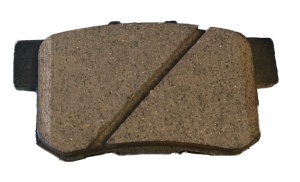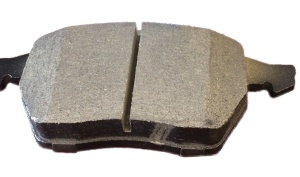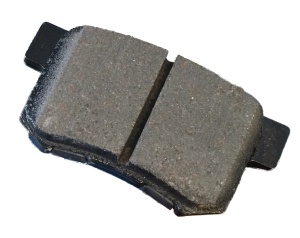With almost a limitless number of manufacturers, performance standards, and ratings for the everyday brake pad, choosing the correct set for your vehicle (regardless of its intended duties) can be a bit of a loaded question. Coupled with the fact that I have yet to meet two car guys with the same preference for a brake set up, I hope to simply provide you with some of the most common brake pad terminologies and familiarize you with what they actually mean, and more importantly what they mean for you.
Let's begin with a simple explanation of what a brake pad does, and though most readers already know this, it will help you understand how the differences in friction material impacts your vehicles braking capabilities when choosing replacement brake pads.
Basic principle
Your brake pad uses your vehicles kinetic energy (energy generated from motion) and converts this into thermal energy (energy from the friction generated when the pad comes into contact with a rotor/drum). When pressure is applied through hydraulic lines in your braking system a caliper or cylinder forces yours pads/shoes towards a spinning disc or drum, to slow or stop your vehicle. In heating the friction material when contacted with a disc/drum it embeds portions of the friction material to the disc/drum better assisting the friction they will generate (one of the reasons you are commonly told to “bed” your brakes after a brake job).
Plain and simple right?
Well, not really, as it gets tricky understanding how well some materials will do the aforementioned and what effects the type of material will have in doing so. Now remember we are going to be talking about the most common options to better assist in the everyday customer (many other options out there and different materials intended for many applications), and give you a better feel for what each pad will do, and how I have felt from being behind the wheel in my own personal experience.
Organic Pads
One of the oldest style friction materials used for manufacturing brake pads many years ago was Asbestos. Used mainly for asbestos’s capabilities for absorbing heat and dissipating it, relatively quickly. Problem was as asbestos deteriorates it create and powdery dust that was dangerous to inhale. Replaced by a safer Organic pad, this contained fibers from rubber and resins as well as Kevlar.

Advantage: In this design these pads are commonly “softer” then most other materials and therefore one of the quieter options you can find. Thus making them harder to hear during day to day function, or even harder braking situations.
Disadvantage: And there are a few, for starters a bit harder to find then the more popular brake pad sets available (I had to do a bit of scouring to find this set from old stock in our warehouse, by scouring I mean diving through piles of 20 year old brake pad boxes, turns our this fits a late 80’s Acura Legend ironically I had one of those). Second, being of a softer material they wear relatively faster than the more common lot, creating a large amount of brake dust in the process. Not very complementing, as you would be going through pads faster and cleaning your wheels more frequently.
My Opinion: Having driven several vehicles still equipped with organic pads I will attest to quiet application and decent feel, given the size of the vehicle I was in at the time (Renault 5) I have to say the feel was average at best, not spongy but still not firm enough to make me feel confident under moderate to severe braking conditions.
Notice the cross notch in the center of the pad better assisting in heat dissipation and ventilation.
Metallic Brake Pads
The most common of the bunch and my personal favorite (but I will get into that later). Metallic brake pads are what you will find in most cars on the road today. Metallic brake pads are comprised of harder metals like copper iron and steel.
Advantage: Highly common and very affordable to make, most manufacturers will offer a line of metallic pads specifically, making them very affordable to the average consumer. Metallic pads are also likely the most durable set of brake pads available given their high metal content and heat transfer characteristics. They also provide reliable stopping power and last longer than most other brake pads. These pads are also great at stopping larger vehicles or heavier models with relative ease.
Disadvantage: They higher metal content in these pads also mean more wear on the contact surface of the rotors/drums then most options available, as the metal tends to “chew” through more of the rotor than usual. Also will sometimes require a bit of heat to function the best, for example on a cold morning brake pedal compression may feel longer than usual. Also though these pads produce less dust then an organic pad, the still produce some that can be relatively annoying to some.
My Opinion: Honestly the best option I have ever encountered when replacing pads, pedal feel is usually firm and pedal application feels crisp and responsive. My current vehicle (2010 Honda Civic Sedan) does not have the luxury of rear disc brakes, so a majority of my braking is handled up front (still would have been the case anyway, being a FWD vehicle), and though this car is 100% factory, I feel confident in my braking capabilities and wear. Metallic pads offer the best all-around stopping power and reliability, and this in my opinion outweighs any disadvantage.
Ceramic Brake Pads
Ceramic brake pads offer exceptional braking performance, wear as good if not better than other options, and are very lightweight (better for unsprung weight). Put together from ceramic fibers mostly, bonded with small flakes of copper.
Advantage: Because of the ceramic compound on these pads, they dissipate heat very well, making them not so prone to brake fade under continued use. Ceramic pads will also not break down as easily as most other pads. On an aesthetic note, though ceramic brake pads do produce dust, it is lighter in color and will not stick to wheels as commonly as other materials.
Disadvantage: Ceramic pads are usually a lot more expensive than their counterparts, sometimes being considerably more costly then metallic options. Also ceramic pads, like metallic pads, require some heat for pedal feel to feel as normal.
Note the slight shimmer from the copper flakes on the surface of these Akebono pads.
My Opinion: Have driven several models with Ceramic pads and most recently a 2006 BMW 325I I owned a few years back. I was way past a brake job at one point so decided to purchase a complete set of Akebono Ceramic front and rear pads. And I have to admit though the braking performance was very good, I could never get use to the cold start up pedal feel. I always understood they would react as such on occasion but I was never really comfortable with it. Once they were warm however, after some light driving, the performance was incredible.
I wanted to offer a better understanding of how each material will perform and what to expect. Now I know there are countless other variables that can determine brake pedal feel, braking performance, and reliability (as every driver is different). And I know, as you do, there are hundreds of other brands, countless brake specifications, and specific applications out there, made it a point to omit that and keep this discussion as to the point as can be. I simply want to shine a bit of light on a few options most car owners will deal with. I omitted rotors from the conversation, though important to the argument for braking performance, as they were already covered in another article from Gareth Foley below, another great read.
Upgrading Brakes: Are Drilled or Slotted Rotors Better?













